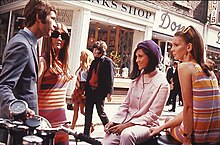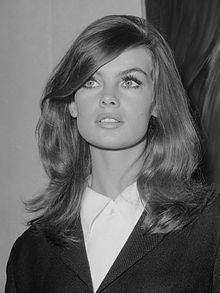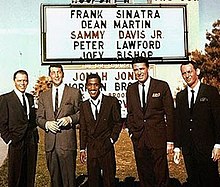1960s in fashion


Fashion of the 1960s featured a number of diverse trends, as part of a decade that broke many fashion traditions, adopted new cultures, and launched a new age of social movements. Around the middle of the decade, fashions arising from small pockets of young people in a few urban centers received large amounts of media publicity, and began to heavily influence both the
In the early-to-mid 1960s, London "Modernists" known as Mods influenced male fashion in Britain.[4] Designers were producing clothing more suitable for young adults, leading to an increase in interest and sales.[5] In the late 1960s, the hippie movement also exerted a strong influence on women's clothing styles, including bell-bottom jeans, tie-dye and batik fabrics, as well as paisley prints.
Women's fashion
Early 1960s (1960–1962)
High fashion
Fashions in the early years of the decade reflected the elegance of the First Lady,
The rise of trousers for women

The 1960s were an age of fashion innovation for women. The early 1960s gave birth to
Mid 1960s (1963–1966)
Bikini

The modern bikini, named after the nuclear test site on Bikini Atoll, was invented in France by Louis Réard in 1946 but struggled to gain acceptance in the mass-market during the 1950s, especially in America. In 1963, rather large versions of bikinis featured in the surprise hit teen film Beach Party, which led a wave of films that made the bikini a pop-culture symbol.
The first Sports Illustrated Swimsuit Issue, in 1964, featured Babette March in a white bikini on the cover.[9] This has been credited with making the bikini a legitimate piece of clothing.[10]
Monokini
The monokini, also known as a "topless bikini" or "unikini",[11][12] was designed by Rudi Gernreich in 1964, consisting of only a brief, close-fitting bottom and two thin straps;[13] it was the first women's topless swimsuit.[14][15] Gernreich's revolutionary and controversial design included a bottom that "extended from the midriff to the upper thigh"[16] and was "held up by shoestring laces that make a halter around the neck."[17] Some credit Gernreich's design with initiating,[15] or describe it as a symbol of, the sexual revolution.[18]
Space Age fashions

Space age fashion first appeared in the late 1950s,
The space age look was defined by boxy shapes, thigh length hemlines and bold accessories. Synthetic material was also popular with space age fashion designers. After the Second World War, fabrics like nylon, corfam, orlon, terylene, lurex and spandex were promoted as cheap, easy to dry, and wrinkle-free. The synthetic fabrics of the 1960s allowed space age fashion designers such as the late
Footwear for women included low-heeled sandals and kitten-heeled pumps, as well as trendy white
The French designer André Courrèges was particularly influential in the development of space age fashion. The "space look" he introduced in the spring of 1964 included trouser suits, goggles, box-shaped dresses with high skirts, and go-go boots. Go-go boots eventually became a staple of go-go girl fashion in the 1960s.[30] The boots were defined by their fluorescent colors, shiny material, and sequins.[31]
Other influential space age designers included Pierre Cardin, Paco Rabanne, Rudi Gernreich,[32] Emanuel Ungaro, Jean-Marie Armand,[33] Michèle Rosier, and Diana Dew, though even designers like Yves Saint Laurent[34][35][36][37] showed the look during its peak of influence from 1963 to 1967.[38][39] Italian-born Pierre Cardin[40] was best known for his helmets, short tunics, and goggles.[40] However, Paco Rabanne has been credited as the one who revolutionized the Space Age fashion.[41] Rabanne was known for his 1966 "12 Unwearable Dresses in Contemporary Materials" collection,[21] made of chain mail, aluminum, and plastic.[42] Rabanne would even design the iconic green dress, as well as the other costumes, Jane Fonda wore in the 1968 science fiction film Barbarella.[43][44] People Magazine journalist Hedy Philips described Rabanne's Space Age fashion as "turning the fashion world upside down."[45]
A timeless fashion piece: miniskirt
The definition of a miniskirt is a skirt with a hemline around 6, 7 inches above the knees. Early references to the miniskirt from the Wyoming newspaper The Billings Gazette, described the miniskirt as a controversial item that was produced in Mexico City.[citation needed] During the 1950s, the miniskirt began appearing in science fiction films like Flight to Mars and Forbidden Planet.[46]
As teen culture became stronger, the term "Youthquake" came to mean the power of young people. This was unprecedented before the 1960s. Before World War II, teenagers dressed and acted like their parents. Many settled down and began raising families when they were young, normally right after high school. They were often expected to work and assist their families financially. Therefore, youth culture begins to develop only after World War II, when the advancement of many technologies and stricter child labor laws became mainstream. Teenagers during this period had more time to enjoy their youth, and the freedom to create their own culture separate from their parents. Teens soon began establishing their own identities and communities, with their own views and ideas, breaking away from the traditions of their parents.[49] The fabulous "little girl" look was introduced to USA—styling with Bobbie Brooks, bows, patterned knee socks and mini skirts. The miniskirt and the "little girl" look that accompanied it reflect a revolutionary shift in the way people dress. Instead of younger generations dressing like adults, they became inspired by childlike dress.[50]
Second-wave feminism made the miniskirt popular. Women had entered the professional workforce in larger numbers during World War II and many women soon found they craved a career and life outside the home.[51] They wanted the same choices, freedoms, and opportunities that were offered to men.[52]
During the mid-1960s, Mod girls wore very short
Women were inspired by the top models of those days, such as
The Single Girl

Writer Helen Gurley Brown wrote Sex and the Single Girl in 1962. This book acted as a guide for women of any marital status to take control of their own lives financially as well as emotionally.[55] This book was revolutionary since it encouraged sex before marriage; something that was historically looked down upon. With the high success of this book, a pathway was set for media to also encourage this behavior. Betty Friedan also wrote The Feminine Mystique the following year, giving insight into the suburban female experience, further igniting women's push for a more independent lifestyle.[56] The second-wave of feminism was getting its start during this period: pushing for a new feminine ideal to be capitalized on.
Fashion photography in the 1960s represented a new feminine ideal for women and young girls: the Single Girl. 1960s photography was in sharp contrast to the models of the 1920s, who were carefully posed for the camera and portrayed as immobile. The Single Girl represented 'movement'. She was young, single, active, and economically self-sufficient. To represent this new Single Girl feminine ideal, many 1960s photographers photographed models outside—often having them walk or run in fashion shoots. Models in the 1960s also promoted sports wear, which reflected the modern fascination with speed and the quickening pace of the 1960s urban life. Although the Single Girl was economically, socially and emotionally self-sufficient, the ideal body form was difficult for many to achieve. Therefore, women were constrained by diet restrictions that seemed to contradict the image of the empowered 1960s Single Girl.[57]
Fashion photographers also photographed the Single Girl wearing business wear, calling her the Working Girl. The Working Girl motif represented another shift for the modern, fashionable woman. Unlike earlier periods, characterized by formal evening gowns and the European look, the 1960s Working Girl popularized day wear and "working clothing". New ready to wear lines replaced individualized formal couture fashion. The Working Girl created an image of a new, independent woman who has control over her body.[57]
There was a new emphasis on ready-to-wear and personal style. As the 1960s was an era of exponential innovation, there was appreciation for something new rather than that of quality.[22] Spending a lot of money on an expensive, designer wardrobe was no longer the ideal and women from various statuses would be found shopping in the same stores.
The Single Girl was the true depiction of the societal and commercial obsession with the adolescent look.[22] Particular to the mid-sixties, icons such as Twiggy popularized the shapeless shift dresses emphasizing an image of innocence as they did not fit to any contours of the human body. The female body has forever been a sign of culturally constructed ideals.[58] The long-limbed and pre-pubescent style of the time depicts how women were able to be more independent, yet paradoxically, also were put into a box of conceived ideals.
Dolly Girl
The "Dolly Girl" was another archetype for young females in the 1960s. She emerged in the mid-1960s, and her defining characteristic is the iconic miniskirt. "Dolly Girls" also sported long hair, slightly teased, and childish-looking clothing. Clothes were worn tight fitting, sometimes even purchased from a children's section. Dresses were often embellished with lace, ribbons, and other frills; the look was topped off with light colored tights. Crocheted clothing also took off within this specific style.[59]
Corsets, seamed tights, and skirts covering the knees were no longer fashionable. The idea of buying urbanized clothing that could be worn with separate pieces was intriguing to women of this era. In the past, one would only buy specific outfits for certain occasions.[60]
Late 1960s (1967–1969)
The hippie subculture
Starting in 1967, youth culture began to change musically and Mod culture shifted to a more laid back
Fringed buck-skin vests, flowing caftans, the "lounging" or "hostess" pajamas were also popular. "Hostess" pajamas consisted of a tunic top over floor-length culottes, usually made of polyester or chiffon. Long maxi coats, often belted and lined in sheepskin, appeared at the close of the decade. Animal prints were popular for women in the autumn and winter of 1969. Women's shirts often had transparent sleeves. Psychedelic prints, hemp and the look of "Woodstock" emerged during this era.[citation needed]
Indian fashion
In general, urban Indian men imitated Western fashions such as the
Feminist influences
During the late 1960s, there was a
Men's fashion
Early 1960s (1960–1962)
Business wear

During the early 1960s, slim fitting single breasted continental style suits and skinny ties were fashionable in the UK and America. These suits, as worn by
Ivy League
Mid 1960s (1963–1966)
Surf fashion
In America and Australia,
The Pendleton Surf Jacket expanded upon Fifties pop-cultural fashions, however new in its relaxed, intangibly cool vibe. The surf jacket split from the tough guy rock 'n' roll teen, and mellowing leather's rock attitudes to woolen plaids. Following
As surfers banded over
The Sixties invented the Californian Cool style, by relaxing style to escape Cold War meltdowns with Polynesian fascinations, bridging the macho 1950s teen towards 1960s Hippie style. The Cold War's tense political context conceived Surf Fashion as a way to relax and escape established violence. California, the birthplace of American Surfing, also produced much of the technology experimentations used in the nuclear space race. Caltech designers in Pasadena were designing nuclear arms for day jobs and were surfing at night. The modern surfboard design itself originates from the military-industrial complex's product development, where the Manhattan Project's Hugh Bradner also designed the modern neoprene wetsuit (Inside the Curl).[78]
Californian engineers for the Cold War were also surfing and equally engineering that fashion. Just as the
Additionally, as Californian water inspired lifestyles influenced fashion, many guys improvised their own
Mod and British Invasion influences

The leaders of mid-1960s style were the British. The Mods (short for Modernists) adopted new fads that would be imitated by many young people. Mods formed their own way of life creating television shows and magazines that focused directly on the lifestyles of Mods.
The Mods' lifestyle and musical tastes were the exact opposite of their rival group, known as the
In the USSR during the mid to late 1960s, Mods and Hippies were nicknamed Hairies for their
Late 1960s (1967–1969)
Folk and counterculture influences

The late 1960s to early 1970s witnessed the emergence of the
Peacock Revolution

By 1968, the space age mod fashions had been gradually replaced by
Hairstyles of the 1960s
Women's hairstyles
Women's hair styles ranged from
During the mid and late 1960s, women's hair styles became
Men's hairstyles
For professional men born before 1940, the side parted
Due to the influence of
Head coverings changed dramatically towards the end of the decade as men's hats went out of style, replaced by the
Image gallery
A selection of images representing the fashion trends of the 1960s:
-
First LadyJacqueline Kennedywearing a red wool dress with matching jacket. She was a fashion icon in the early 1960s.
-
Singer and actress Barbra Streisand in 1962 wearing a top with a crew-neck. Her hair is teased at the crown.
-
Graciela Borges, Argentine fashion icon of the 1960s, wearing a fur coat, bouffant hair and winged eye liner.
-
In 1965, sleevelessshift dresseswere popular with women.
-
Young woman in Florida, 1965.
-
A velvet minidress from 1965.
-
American girl wearing a mini skirt and patterned tights, 1966.
-
Philippine first lady Imelda Marcos with U.S. President Lyndon B. Johnson while sporting her iconic beehive hairstyle, 1966.
-
Fashion model fromGDRwearing a wool suit trimmed with fur and a matching fur hat, 1966.
-
Young woman wears her hair in a headband with flipped ends, 1967.
-
Woman at a Singapore zoo, 1967. Note her Pucci-style print dress.
-
Dress by Paco Rabanne, 1967
-
East German politicians wearingwire rimmed glasses, late 1960s.
-
Argentine actress Nacha Guevara c. 1968.
-
In the late 1960s, brides often wore white mini wedding dresses.
-
Two men at theWoodstock Festival, 1969
-
Boy with amop tophair cut, 1969.
-
Singer Maria Muldaur in 1968, wearing a gypsy-style kerchief and hoop earrings.
See also
Fashion designers
- Barbara Hulanicki
- Rudi Gernreich
- Bill Gibb
- Guy Laroche
- Emilio Pucci
- Jean Muir
- Mary Quant
- Paco Rabanne
- Oscar de la Renta
- Yves Saint-Laurent (designer)
- Mila Schön
Style icons
- Marella Agnelli
- Anouk Aimée
- Brigitte Bardot
- Jane Birkin
- Amanda Burden
- Pattie Boyd
- Claudia Cardinale
- Cher
- Consuelo Crespi
- Julie Christie
- Catherine Deneuve
- Farah Diba
- Faye Dunaway
- Jane Fonda
- Dolores Guinness
- Gloria Guinness
- Audrey Hepburn
- Jacqueline Kennedy
- Sophia Loren
- Babe Paley
- Hope Portocarrero
- Lee Radziwill
- Vanessa Redgrave
- Jacqueline de Ribes
- Diana Ross
- Diana Rigg
- Edie Sedgwick
- Nancy Sinatra
- Queen Sirikit
- Sharon Tate
- Raquel Welch
- Steve Winwood
- Natalie Wood
- Stevie Wright
- Jayne Wrightsman
- Harry Vanda
- Gloria Vanderbilt
Supermodels

Fashion photographers
- Richard Avedon
- David Bailey
- Cecil Beaton
- Hiro (photographer)
- William Klein
- Patrick Lichfield
- Terry O'Neill
- Norman Parkinson
- Lord Snowdon
- Bert Stern
Teenage subcultures
- Greaser subculture
- Rocker subculture
- Raggare
- Bodgies
- Mod subculture
- Soc subculture
- Youthquake
- Surfer
- Beatnik
- Hippie
- Rude Boy
- Skinhead
- Black Panthers
Other
- Carnaby Street
- Miniskirt
- Swinging London
- Twiggy
- Vogue
- Diana Vreeland
References
- ^ a b "Braggs, Steve, and Diane Harris. 60s Mods". Retrowow.co.uk. March 1, 2009.
- ^ Rich Candace (2010–2015). "Makeup". Fiftiesweb.com.
- ^ Vidcat1 (February 13, 2007). "Vintage Fashion Newsreels 1960s". Youtube.com. Archived from the original on 2010-05-07. Retrieved March 27, 2009.
- ^ a b c d "Braggs, Steve, and Diane Harris. 60s Mods". Retrowow.co.uk. March 1, 2009.
- ^ "Goodwin, Susan, and Becky Bradley. American Cultural History: 1960–1969". Kingwood College Library. March 1, 2009. Archived from the original on March 1, 2009.
- ^ "Audrey Hepburn's style hits". Harper's BAZAAR. 2014-05-02. Retrieved 2016-02-08.
- ^ 1962 Sears catalog
- ISBN 0-8109-1693-2.
- ^ Gibson, Megan (5 July 2011). "Top 10 Bikinis in Pop Culture". Time. Retrieved 17 June 2018.
- ^ "The bikini celebrates 60 years". 22 July 2006. Archived from the original on 2008-07-06.
- ^ "Monokini". Archived from the original on 18 August 2015. Retrieved 20 August 2015.
- ^ "Bikini Science". Archived from the original on 2018-01-27. Retrieved 2018-01-27.
- ^ "Monokini". Free Dictionary. Retrieved 20 August 2015.
- ^ Rosebush, Judson. "Peggy Moffitt Topless Maillot in Studio". Bikini Science. Archived from the original on 27 January 2018. Retrieved 27 January 2018.
- ^ ISBN 978-1780429519. Archivedfrom the original on 2018-01-29.
- ^ "Bikini Styles: Monokini". Everything Bikini. 2005. Archived from the original on 29 July 2012. Retrieved 13 January 2013.
- ^ Nangle, Eleanore (June 10, 1964). "Topless Swimsuit Causes Commotion". Chicago Tribune. Archived from the original on 14 September 2015. Retrieved 20 August 2015.
- ^ "Fit Celebrates the Substance of Style". Elle. July 5, 2009. Archived from the original on 24 September 2015. Retrieved 23 August 2015.
- ^ Parnis, Mollie. "Fashion and Dress". 1959 Britannica Book of the Year: Events of 1958. Encyclopaedia Britannica, Inc. p. 247.
In 1958, the 'revolutionary' silhouette was a long, unbroken oval, obviously inspired by a space rocket's shape...
- ^ Fogarty, Anne. "Fashion". The Americana Annual 1959: Events of 1958. Americana Corporation. p. 250.
The chemise...began in Paris in 1957,...variously called the sack, the shift, or the space silhouette...
- ^ ISBN 9781851775446.
- ^ ISBN 9780500516935.
- ^ Pierre Cardin
- ^ Blackwell, Betsy Talbot. "Fashions". The American Peoples Encyclopedia 1966 Encyclopedia Yearbook: Events of 1965. Grolier Incorporated. p. 233.
...she chose...a silver-mesh sweater to pour over silver bell-bottoms. And she would have no trouble finding silver-flecked stockings and silver-kid sandals.
- ISBN 0-14-00-4955-X.
...everything silver, from visor to stockings and shoes...[Y]ou wear silver leather and plastic chain mail...chrome jewellery,...silver stockings, silver shoes laced up the leg, bangles of clear plastic and chrome. Silver leather or shirred silver nylon make the new jackets...
- ^ Blackwell, Betsy Talbot. "Fashions". The American Peoples Encyclopedia 1966 Encyclopedia Yearbook: Events of 1965. Grolier Incorporated. p. 232.
Op art was a natural for fabric design, and many a 1965 shift was opped-up.
- ^ Cassini, Oleg. "Fashion". Collier's 1966 Year Book: Covering the Year 1965. Crowell Collier and MacMillan, Inc. p. 212.
Op Art, the newest in the art world, was quickly incorporated into clothes and makeup....James Galanos fashioned two Op-inspired fabrics...into this dazzling dress, which seems to be part of its background, Op artist Victor Vasarely's kaleidoscopic collage.
- ^ Emerson, Gloria (1966-01-27). "Paris: Strictly for Small-Boned Girls". The New York Times: 37. Retrieved 2023-07-13.
Roger Vivier, who provides most of the new shoes for the haute couture, has made everything in clear plastic this year...
- ^ Hasson, Rachelle. "Fashion". World Book Year Book 1968: Events of 1967. Chicago, Illinois, USA: Field Enterprises Educational Corporation. pp. 336, 338.
Women...fancied high boots as a means of covering their new length of leg. High-rise stretch vinyl or patent leather provided glovelike sleekness...Boots stretched to the knees, to the thighs, or even to cover the entire leg like [a] fisherman's hip boots....Autumn gave new luster to shoes and handbags of patent leather...
- ^ Yotka, Steff (8 January 2016). "Remembering André Courrèges". Vogue. Retrieved 2016-05-19.
- ^ BBC Culture: Space age fashion
- ^ "Fashion for the '70s: Rudi Gernreich Makes Some Modest Proposals". Life. Vol. 68, no. 1. 1970-01-09. pp. 115–118. Retrieved 2022-01-03.
- ^ "Jean-Marie Armand". Couture Allure. 2011-03-08. Retrieved 2021-12-13.
His designs were very modern and architectural, much like those of Courreges and Cardin.
- ISBN 0-14-00-4955-X.
Saint Laurent's black and white geometric shifts...Saint Laurent: Black ciré smock[, helmet,] and thigh-high alligator boots.
- ISBN 978-0-7643-5499-1.
Yves Saint Laurent's fall...1963...visored caps, black leather jerkins, and Roger Vivier's...thigh-high...boots in crocodile gave what [the Daily Mail's Iris] Ashley called 'a real space girl effect...'
- ^ "1965 Homage to Piet Mondrian". Musée Yves Saint Laurent Paris. Retrieved 2022-01-09.
- ISBN 0-14-00-4955-X.
Saint Laurent makes his shifts...transparent except where they are striped or chevroned with silver sequins.
- ISBN 0-14-00-4955-X.
Space projections...plastic, chrome, Dynel...[Y]ou wear...skirts that show the whole length of your legs, mops of artificial hair coloured pink, green and purple...and visor sunglasses....huge plastic disc earrings,...and eye make-up is designed to be seen from 100 yards, in streamlined eyeliners, black and white used alternately...
- ISBN 0-14-00-4955-X.
1967-68...mark[ed] the change in direction from futurist to romantic fashion....[i]n reaction to the uniformity of geometric haircuts and 'functional' fashion, stiff carved tweed shifts and creaking plastic...
- ^ a b "Pierre Cardin". Encyclopædia Britannica. 2016. Retrieved 2016-05-18.
- ^ Owoseje, Toyin; Siad, Amaud (3 February 2023). "Paco Rabanne, Spanish fashion designer known for his Space Age creations, dies at 88". CNN. Retrieved 3 February 2023.
- ISBN 978-1592536771.
- ^ Leung, Yasmine (3 February 2023). "Who Owns Paco Rabanne Now? Visionary Designer Dies Aged 88". HITC. Retrieved 3 February 2023.
- ^ Goodfellow, Melanie (3 February 2023). "Paco Rabanne Dies: Spanish 'Barbarella' Fashion Designer Was 88". Deadline Hollywood. Retrieved 3 February 2023.
- ^ Philips, Hedy (3 February 2023). "Spanish Fashion Designer Paco Rabanne Dies at Age 88". People.com. Retrieved 3 February 2023.
- ^ Parks, C. (2015, March 23). The Miniskirt: An Evolution From The '60s To Now. Retrieved October 30, 2016, from http://www.huffingtonpost.com/2015/03/23/mini-skirt-evolution_n_6894040.html
- ^ Paula Reed. (2012). In Fifty Fashion Looks that Changed the 1960s (pp. 30–31). England: Alison Starling.
- ^ Koda, H. (2010). 100 Dresses: The Costume Institute, The Metropolitan Museum of Art. S.l.: Yale University Press.
- ^ Blackman, C. (2012). 100 Years of Fashion. London: Laurence King Pub.
- ^ Nectara, J (2012, July 13). "The Miniskirt – A Short History." Retrieved October 30, 2016, from [1]
- ^ Bourne, L. (2014). "A history of the Miniskirt: How fashion's most daring hemline came to be." Retrieved October 30, 2016, from http://stylecaster.com/history-of-the-miniskirt/
- ^ Niara. (2016, January 9). "Aesthetics and Activism: The history of miniskirt." Retrieved October 30, 2016, from http://www.collegefashion.net/inspiration/the-history-of-the-miniskirt/
- ^ Tarrant, Naomi (1994). The Development of Costume. London: Routledge. p. 88.
- ^ Contini, p. 317
- ISBN 9781569802526.
- ISBN 0-393-32257-2.
- ^ ISBN 1859734448.
- S2CID 143932525.
- ISBN 0851122345
- ^ Belinda T. Orzada (2000-01-10). "Orzada, Belinda T. "Fashion Trends and Cultural Influences 1960-present." Twentieth Century Design: Ethnic Influences. 7 Oct. 1998. University of Delaware. 10 Apr. 2009". Udel.edu. Archived from the original on 2012-06-18. Retrieved 2012-08-11.
- ^ Hosiery Trends Over The Decades
- ISBN 1402714424.
- ^ "Reading Eagle - Google News Archive Search". news.google.com.
- ^ "Gadsden Times - Google News Archive Search". news.google.com.
- S2CID 143094250.
- ^ Duffett, Judith (October 1968). WLM vs. Miss America. Voice of the Women's Liberation Movement. p. 4.
- ^ "A guide to Suit Problems for men". 11 December 2012. Archived from the original on February 14, 2013.
- ^ "Mohair Suiting Fabric Guide—Gentleman's Gazette". www.gentlemansgazette.com. 28 November 2015.
- ^ "The History And Abuse of The Fedora". Archived from the original on 2017-05-14. Retrieved 2017-11-25.
- ^ "Top Hats and Bibles: Inauguration Traditions". ABC News. 19 January 2009.
- Independent.co.uk. 2010-09-19. Archivedfrom the original on 2022-05-01.
- ^ "Claudio De Rossi talks Ivy with Jimmy Frost Mellor - Modculture". 26 October 2017.
- ^ "The Ivy Style Primer—Gentleman's Gazette". www.gentlemansgazette.com. 13 July 2018.
- ^ "Pendleton Woolen Mills - An Unlikely Surf Icon". Heddels. 2016-09-12. Retrieved 2018-04-15.
- ISBN 9781847888563.
- ^ "Retro 1960s Swimwear, Beachwear and Surf Fashion". Dust Factory Vintage Clothing Wholesale. 2016-06-26. Retrieved 2018-04-15.
- ^ "The History of Flannel - Gear Patrol". Gear Patrol. 2014-10-02. Retrieved 2018-04-15.
- ^ "Inside the Curl: Surfing's Surprising History". 2013-08-04. Archived from the original on August 6, 2013. Retrieved 2018-04-15.
- ^ Martin D. Henry (ITQ, vol. 63/3, 1998, 250–62)
- ISBN 9781458429148– via Google Books.
- ^ Zhito, Lee (29 June 1963). "Surfing Craze Ready to Splash Across Country to East's Youth". Billboard. Nielsen Business Media, Inc. p. 26 – via Google Books.
- ISBN 0-7876-5422-1.
- ^ "For Your Love: The Best of the Sixties British Invasion". Rolling Stone. 2014-06-02. Retrieved 2016-02-08.
- ISBN 9781466864979– via Google Books.
- ^ Safanov, Mikhail (8 August 2003). "Confessions of a Soviet moptop". The Guardian.
- ^ "Photos of hippies". Archived from the original on 2016-07-03. Retrieved 2017-11-27.
- ^ "Troubled Times: 1961–79 – Fashion, Costume, and Culture: Clothing, Headwear, Body Decorations, and Footwear through the Ages". www.fashionencyclopedia.com. Retrieved 2017-10-07.
- ^ "Bell-Bottoms facts, information, pictures | Encyclopedia.com articles about Bell-Bottoms". www.encyclopedia.com. Retrieved 2017-10-07.
- ^ "The Peacock Revolution". The Peacock Revolution and the Beatles: British Men's Fashion from 1963–1973. Retrieved 2017-10-07.
- ^ Marshall, Peter (February 27, 2009). "Peacock Revolution: Informal Counterculture". Black-tie-guide 2009. Archived from the original on 2016-10-19.
- ^ Collins, Amy Fine (1 June 2003). "It had to be Kenneth.(hairstylist Kenneth Battelle)(Interview)". Vanity Fair. Retrieved 3 December 2012.
- ISBN 9780313359491.
- ISBN 0-7876-5422-1.
- ISBN 0-7876-5422-1.
External links
- "Collection highlights". Fashion, Jewellery & Accessories. 1960s Fashion and Textiles collection. Victoria and Albert Museum. Retrieved 2007-06-08.
- "60s Fashion in the Round". Fashion, Jewellery & Accessories. Victoria and Albert Museum. Archived from the original on 2007-11-26. Retrieved 2007-12-09.
- "1960s - 20th Century Fashion Drawing and Illustration". Fashion, Jewellery & Accessories. Victoria and Albert Museum. Archived from the original on 2011-07-14. Retrieved 2011-04-03.
- "Swing Fashion – Coats and Jackets". Swing Fashion. Fashion Ode. Archived from the original on 2014-12-23. Retrieved 2014-12-23.
- Everyday Life in the 1960s - Expired Knowledge






















